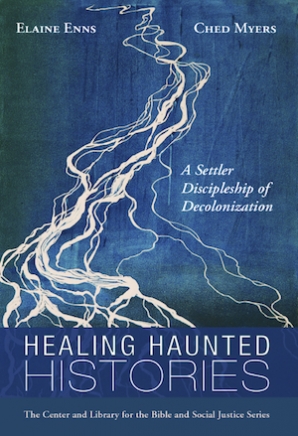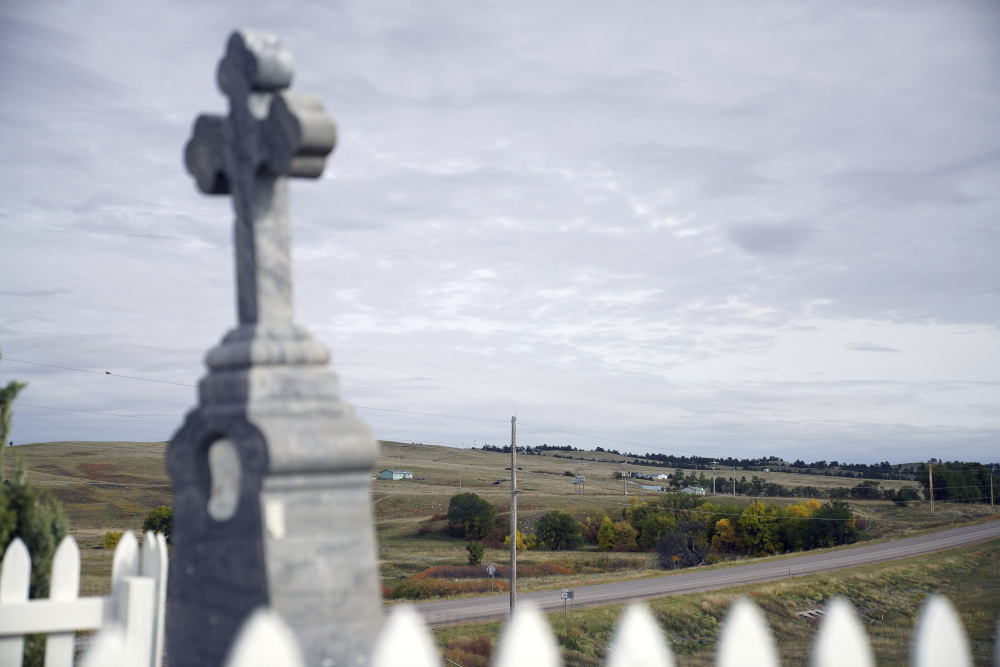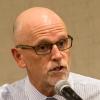
David Chartrand, president of the Manitoba Métis Federation, gestures with this fist following a meeting of a Canadian Métis delegation with Pope Francis at the Vatican April 21. The pope has met this year with several Indigenous groups from Canada as an effort at reconciliation between the Indigenous community and the Catholic Church. (CNS/Paul Haring)
How can the Catholic Church in the United States resist the temptation of seductively false accounts of the nation's founding that fuel the sin of nationalism?

I mean the seduction evident when state laws prohibit the use of the New York Times' 1619 Project in history classes and thereby obscure an honest engagement with slavery's place in the founding of the country or when the continent-wide dispossession of Indigenous land is explained away as a regrettable consequence of the advancement of Christian civilization. Such evasions of truth-telling subordinate objective claims of morality to the imperatives of national myth.
I am aware of the heroic work of history teachers at all levels of Catholic schools committed to an honest engagement with our difficult past. I'm also aware of notable public efforts aimed at truth, reparation and reconciliation like Georgetown University's atonement for its slave owning past; or the truth and healing process undertaken at the Red Cloud Indian School on the Pine Ridge Reservation; or the "Reckoning with our Mission Histories" project of the Los Angeles Catholic Worker that invites the L.A. Archdiocese to explore the truths of the California mission system.
But it's time for the Catholic Church in the United States to develop a more comprehensive and consistent stance toward addressing our troubled American past and the church's role in it.
Healing Haunted Histories: A Settler Discipleship of Decolonization by Elaine Enns and Ched Myers could be a big help in that effort. The book is founded on the bedrock of objective morality that Enns and Myers neither avoid nor mitigate: The continent-wide theft of Indigenous land that made possible the establishment of the United States and Canada.

Pine Ridge Indian Reservation is seen from the burial place of Chief Red Cloud, the 19th century warrior, Sept. 30, 2021 in Pine Ridge, S.D. Red Cloud defended against U.S. land grabs as long as he could but converted to Catholicism and invited the Jesuits to start Holy Rosary Mission after he and his people were confined to Pine Ridge. (AP/Emily Leshner)
In the face of such a vast injustice, the book essentially responds to the question: What should a Christian settler in the U.S. or Canada today do to make right such a wrong? By "settler," they mean any non-Indigenous persons living now on stolen lands (they except enslaved persons and their descendants from the group of settlers).
This brave, unflinching book falls outside the usual categories of genre. In compelling fashion, it combines personal narrative, Indigenous history and culture, decolonial and post-traumatic theory, biblical exegesis and theological reflection. Enns brings to the work her expertise on restorative justice; Myers is a noted New Testament scholar. They approach the project from their shared Mennonite tradition.
Enns and Myers are keenly aware of the many ways that Christians today dismiss this primal injustice (the authors acknowledge their own tendency to do so). They understand, too, that today's settler inhabitants of North America did not themselves commit the original sin of violent dispossession ("This history is not your fault, but it is absolutely your responsibility," they quote Indigenous filmmaker Nikki Sanchez as saying).
At the heart of the book is Enns' immigrant family's story from their fraught departure from Ukraine in the early 20th century amid the chaotic aftermath of the Russian Revolution to their settlement in Saskatchewan in a large Mennonite farming community to Enns' own migration to her residence now near Santa Barbara, California.
Enns' deep and moving dive into her story draws on the concept of "storylines" applied to three key realities of her family's epic and everyman trek. First, there are "landlines." These are the stories of the land itself — its soil, waterways, deeds of ownership, etc. — that propel migration and shape the arrival of migrants to a new country. Then there are "bloodlines," the stories of good and evil that families carry or conjure as they go from one land to the next. Finally, there are "songlines," those sources of hope and healing that accompany migration.
In telling her story, Enns shows the precise ways in which her family — like every other settler family — heroically sought a new life and also benefited from stolen goods. They fled persecution. They crossed vast stretches of land and water to come to what was for them a new and promising world. But when they arrived as farmers in Canada, they were settled by government policy on land that only a few years before had been taken from Cree Indian tribes. The creation of the Canadian nation required the domestication of farmland, not the continued presence of nomadic peoples.
Advertisement
In response to this historic theft, Enns and Myers call for restorative justice over the long haul. We must look for large and small ways to acknowledge the truth of the past and make reparation, including finally the return of the stolen land to its rightful owners. This work of discipleship, they say, is "necessary for Christians who would follow a Jesus who was executed by a colonial state; reckon with the long and lamentable history of a colonizing Christendom; and care for a future of the church as a 'House for all peoples.' "
There are many things to learn from Healing Haunted Histories. But the most important comes from its essentially Christian inspiration to seek the redemption of historical wrongdoing.
The Catholic Church in the United States should face our difficult past neither intent on saving national myths nor on vindicating postmodern identity theory. Instead, the essential inspiration should come from the convictions of Christian faith.
St. John Paul II showed the way during the Jubilee Year in 2000 when he apologized on behalf of the church for numerous historical wrongs. A Vatican document called "Memory and Reconciliation" provided theological justification for that Jubilee Year and explained that, in the eyes of faith, the interpretation of the "bond between past and present is not motivated only … by the common belonging of every human being to history … but is based also on the unifying action of the Spirit of God."
The Spirit orients us toward truth and the possibilities of reconciliation. And, the Vatican document notes, we should turn in such a direction confident that "taking responsibility for past wrongs is a kind of sharing in the mystery of Christ, crucified and risen, who took upon himself the sins of all."
Now that's the spirit the Catholic Church should bring to the battles over history raging across Turtle Island, as the Indigenous called North America.








